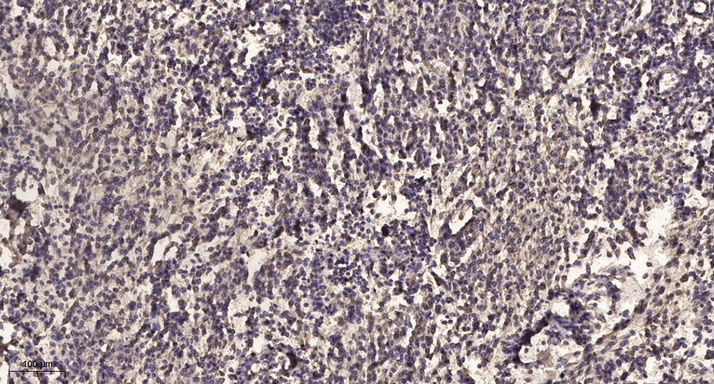Latrophilin-1 Polyclonal Antibody
- Catalog No.:YT2541
- Applications:WB;ELISA;IHC
- Reactivity:Human;Mouse;Rat
- Target:
- Latrophilin-1
- Gene Name:
- LPHN1
- Protein Name:
- Latrophilin-1
- Human Gene Id:
- 22859
- Human Swiss Prot No:
- O94910
- Mouse Gene Id:
- 330814
- Mouse Swiss Prot No:
- Q80TR1
- Rat Gene Id:
- 65096
- Rat Swiss Prot No:
- O88917
- Immunogen:
- The antiserum was produced against synthesized peptide derived from human LPHN1. AA range:561-610
- Specificity:
- Latrophilin-1 Polyclonal Antibody detects endogenous levels of Latrophilin-1 protein.
- Formulation:
- Liquid in PBS containing 50% glycerol, 0.5% BSA and 0.02% sodium azide.
- Source:
- Polyclonal, Rabbit,IgG
- Dilution:
- WB 1:500-2000;IHC 1:50-300; ELISA 2000-20000
- Purification:
- The antibody was affinity-purified from rabbit antiserum by affinity-chromatography using epitope-specific immunogen.
- Concentration:
- 1 mg/ml
- Storage Stability:
- -15°C to -25°C/1 year(Do not lower than -25°C)
- Other Name:
- LPHN1;KIAA0821;LEC2;Latrophilin-1;Calcium-independent alpha-latrotoxin receptor 1;CIRL-1;Lectomedin-2
- Molecular Weight(Da):
- 163kD
- Background:
- This gene encodes a member of the latrophilin subfamily of G-protein coupled receptors (GPCR). Latrophilins may function in both cell adhesion and signal transduction. In experiments with non-human species, endogenous proteolytic cleavage within a cysteine-rich GPS (G-protein-coupled-receptor proteolysis site) domain resulted in two subunits (a large extracellular N-terminal cell adhesion subunit and a subunit with substantial similarity to the secretin/calcitonin family of GPCRs) being non-covalently bound at the cell membrane. Latrophilin-1 has been shown to recruit the neurotoxin from black widow spider venom, alpha-latrotoxin, to the synapse plasma membrane. Alternative splicing results in multiple variants encoding distinct isoforms.[provided by RefSeq, Oct 2008],
- Function:
- domain:The extracellular domain coupled to the a single transmembrane region are sufficient for full responsiveness to alpha-latrotoxin.,function:Calcium-independent receptor of high affinity for alpha-latrotoxin, an excitatory neurotoxin present in black widow spider venom which triggers massive exocytosis from neurons and neuroendocrine cells. Receptor propably implicated in the regulation of exocytosis.,PTM:Proteolytically cleaved into 2 subunits, an extracellular subunit and a seven-transmembrane subunit. This proteolytic processing takes place early in the biosynthetic pathway, either in the endoplasmic reticulum or in the early compartment of the Golgi apparatus.,similarity:Belongs to the G-protein coupled receptor 2 family. LN-TM7 subfamily.,similarity:Contains 1 GPS domain.,similarity:Contains 1 olfactomedin-like domain.,similarity:Contains 1 SUEL-type lectin domain.,subunit:Form
- Subcellular Location:
- Cell membrane; Multi-pass membrane protein. Cell projection, axon . Cell projection, growth cone . Cell junction, synapse . Cell junction, synapse, presynaptic cell membrane . Cell junction, synapse, synaptosome . Colocalizes with TENM2 on the cell surface, across intercellular junctions and on nerve terminals near synaptic clefts. .
- Expression:
- Brain,Lung,T-cell,Whole embryo,
- June 19-2018
- WESTERN IMMUNOBLOTTING PROTOCOL
- June 19-2018
- IMMUNOHISTOCHEMISTRY-PARAFFIN PROTOCOL
- June 19-2018
- IMMUNOFLUORESCENCE PROTOCOL
- September 08-2020
- FLOW-CYTOMEYRT-PROTOCOL
- May 20-2022
- Cell-Based ELISA│解您多样本WB检测之困扰
- July 13-2018
- CELL-BASED-ELISA-PROTOCOL-FOR-ACETYL-PROTEIN
- July 13-2018
- CELL-BASED-ELISA-PROTOCOL-FOR-PHOSPHO-PROTEIN
- July 13-2018
- Antibody-FAQs
- Products Images

- Immunofluorescence analysis of LOVO cells, using LPHN1 Antibody. The picture on the right is blocked with the synthesized peptide.

- Immunohistochemical analysis of paraffin-embedded human meningioma. 1, Antibody was diluted at 1:200(4° overnight). 2, Tris-EDTA,pH9.0 was used for antigen retrieval. 3,Secondary antibody was diluted at 1:200(room temperature, 45min).



